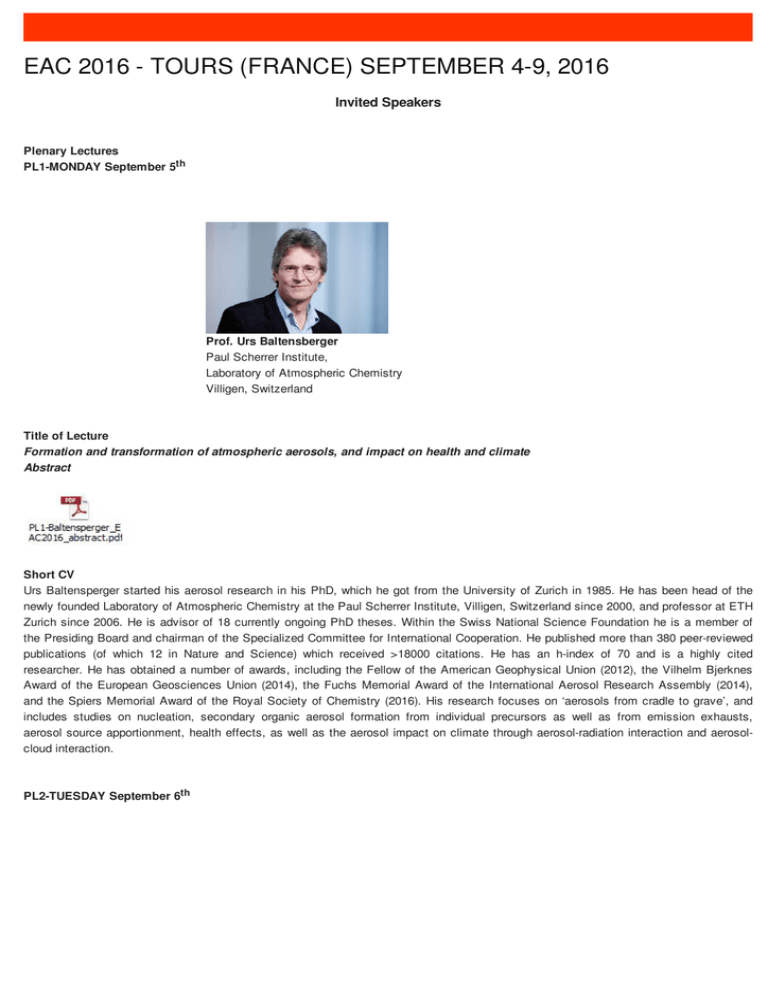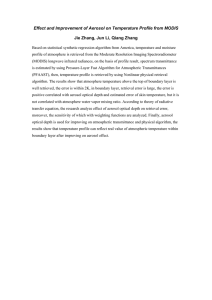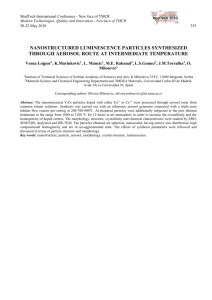EAC 2016 - TOURS (FRANCE) SEPTEMBER 4-9, 2016
advertisement

EAC 2016 - TOURS (FRANCE) SEPTEMBER 4-9, 2016 Invited Speakers Plenary Lectures PL1-MONDAY September 5th Prof. Urs Baltensberger Paul Scherrer Institute, Laboratory of Atmospheric Chemistry Villigen, Switzerland Title of Lecture Formation and transformation of atmospheric aerosols, and impact on health and climate Abstract Short CV Urs Baltensperger started his aerosol research in his PhD, which he got from the University of Zurich in 1985. He has been head of the newly founded Laboratory of Atmospheric Chemistry at the Paul Scherrer Institute, Villigen, Switzerland since 2000, and professor at ETH Zurich since 2006. He is advisor of 18 currently ongoing PhD theses. Within the Swiss National Science Foundation he is a member of the Presiding Board and chairman of the Specialized Committee for International Cooperation. He published more than 380 peer-reviewed publications (of which 12 in Nature and Science) which received >18000 citations. He has an h-index of 70 and is a highly cited researcher. He has obtained a number of awards, including the Fellow of the American Geophysical Union (2012), the Vilhelm Bjerknes Award of the European Geosciences Union (2014), the Fuchs Memorial Award of the International Aerosol Research Assembly (2014), and the Spiers Memorial Award of the Royal Society of Chemistry (2016). His research focuses on ‘aerosols from cradle to grave’, and includes studies on nucleation, secondary organic aerosol formation from individual precursors as well as from emission exhausts, aerosol source apportionment, health effects, as well as the aerosol impact on climate through aerosol-radiation interaction and aerosolcloud interaction. PL2-TUESDAY September 6th Prof. Paolo Milani University of Milano Department of Physics Milano, Italy Title of Lecture Supersonic Cluster Beam Deposition of Nanostructured Devices and Nanocomposites for Biomedical and Clinical Applications Abstract Short CV Paolo Milani is Full Professor at the Department of Physics of the University of Milano. His research focuses on cluster-assembled nanostructured materials and their integration on microfabricated platforms by exploiting the supersonic cluster beam deposition technology. He is active in the field of nanostructured systems and devices for stretchable electronics, optics, soft robotics, biotechnology and medicine. He has published more than 230 papers on refereed journals, several review papers and a monograph on supersonic cluster beam deposition for the synthesis of nanostructured thin films. Currently, Milani serves as Director of the Interdisciplinary Centre for Nanostructured Materials and Interfaces of the University of Milano. He is also Coordinator of the PhD School in Medical Nanotechnology supported by the European School of Molecular Medicine and the University of Milano. He is co-editor of the Springer book series Carbon Materials Chemistry and Physics, regional editor for Europe of the Journal of Nanoparticle Research, member of the editorial board of Advances in PhysicsX and of KONA Powder and Particle Journal. He is co-founder of three start-up companies: TETHIS spa active in the field of nanostructured systems for biomedical microdevices, WISE srl producing stretchable electronics for neuromodulation, and EOS srl producing optical systems for nanoparticle sizing in biological media. PL3-WEDNESDAY September 7th Prof. J. Brian A. Mitchell University of Rennes I, France Title of Lecture Free nanoparticle studies using synchrotron radiations Abstract Short CV J. Brian A. Mitchell was born in Northern Ireland and received his BsC Hons. Degree and PhD (in the field of Atomic Collisions Research) from Queen’s University, Belfast. After graduation he emigrated to Canada where, first as a postoctoral research fellow and then as a research associate and finally as a Full Professor, he worked in and later directed the Atomic Collisions research there, in a pioneering laboratory in the use of the Merged Electron-Ion Beam technique for the study of low energy, electron-ion collision processes. As an interim, during his early years in North America, he spent two years at the Brookhaven National Laboratory in New York, where he designed a molecular physics beamline for the National Light Source (NLS) synchrotron, under development, at that time. While at Brookhaven, and later again in Canada, he developed an interest in combustion research, working on additives for smoke reduction in large fires. This work led, in collaboration with Imperial Oil, EXXON Chemical Co. and the US Air Force, to the development of « Tekflame », a low smoke product used for firefighter training. In 1996, he returned to Europe to take up a professorship at the University of Rennes I in Brittany, France. His work on recombination continued there but in 2002, he returned again to synchrotron radiation, this time to study soot formation processes in combustion using Small Angle X-Ray Scattering, X-Ray Photoelectron Spectroscopy, and X-ray induced ionisation. He then extended this combustion work to the examination of nanoparticle formation processes in other extreme environments such as microwave air plasmas, electrical arcs and laser ablation plumes. Other research interests include the use of mass spectrometry for buried oil detection, and Ball Lightning Research. He has over 150 journal and conference articles published and is the co-author of a text book on Heavy Particle Atomic Collisions. PL4-THURSDAY September 8th Prof. Kari Lethinen University of Eastern Finland and Finnish Meteorological Institute, Head of Department Kuopio, Finland Title of Lecture On theory, modelling and data analysis of atmospheric aerosol formation and growth Abstract Short CV Kari Lehtinen received his degrees (M.Sc. 1992, Lic. Tech. 1993, Ph.D. 1997) at Helsinki University of Technology (HUT), Dept. Technical Physics. Before becoming Professor of Atmospheric Physics and Chemistry he was assistant of mechanics and computational dynamics at HUT, a researcher and a senior researcher at VTT Energy and a senior researcher and a university lecturer at Helsinki University, Dept. Atmospheric Sciences. He was a visiting scientist in UCLA Los Angeles in 1994-1995 and University of Minnesota Minneapolis in 20002001. The professorship is a joint position between UEF and the Finnish Meteorological Institute (FMI). In 2004-2013 Lehtinen was head of FMI Kuopio Unit, a research unit with research groups in atmospheric modeling, measurements and radiation as well as aviation and military weather service. Since then, from Jan 2014, he has been the head of UEF Department of Applied Physics. His main research interests are aerosol microphysics theory and modeling related to various applications in atmospheric science, nanomaterial synthesis and environmental health. Kari Lehtinen has published more than 170 peer reviewed international journal Articles (2 in Science) and supervised 16 Ph.D. theses. He is an editor of ‘Atmospheric Chemistry and Physics' and and a member of FAAR, GAEF, AAAR and AGU. His teaching experience includes courses in computational dynamics, aerosol physics and dynamics, transport phenomena, statistical physics as well as basic undergraduate physics. PL5-FRIDAY September 9th Dr. Nathalie Heuzé-Vourc’h National Institute of Biomedical Research INSERM, University of Tours Tours, France Title of Lecture Aerosoltherapy of Monoclonal Antibodies for Respiratory Diseases Abstract Short CV Nathalie Heuzé-Vourc’h (Ph.D., INSERM CR1) is a senior research scientist at the National Institute of Biomedical Research in Tours, France. She co-leads a multidisciplinary team in the Research Centre for Respiratory Diseases (CEPR, INSERM U1100) dedicated on Aerosoltherapy and Biologics for Respiratory Diseases (team 3). After graduating her PhD in oncology in France, she focused her research on lung diseases and obtained a postdoctoral position in the Division of Pulmonary and Critical Care Medicine (Dr Steven M. Dubinett) at UCLA, California. She gained interest in biotherapeutics working in a start-up (Agensys Inc., Santa Monica, California) developing anticancer monoclonal antibodies and was recruited in 2005 by INSERM as a young research scientist to continue working on this topic. Joining Pr Patrice Diot’s research group specialized on the delivery of drug by aerosol in Tours offered her new perspectives on her research projects as she started investigating the local delivery of monoclonal antibodies through the airways. She is currently supervising several projects on the multifaceted aspects of the delivery of biotherapeutics through the airways for treatments of lung diseases, from formulation to preclinical safety, with both academic and private partners. She is a member of the labEx MAbImprove, labeled “Laboratoire d’Excellence” as part of the “Investment for the Future” project launched by the French government and funded for 10 years, and co-lead one of its research axis. Presently, she is co-author of more than 40 publications.





